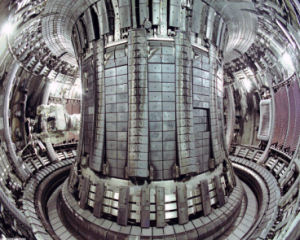|

Cutaway
diagram of the JET torus (photograph courtesy of EFDA-JET). The JET
machine is a large tokamak device of approximately 12 metres high. At the
heart of the machine there is a toroidal (ring-shaped) vacuum vessel of
major radius 2.96 metres with a D-shaped cross-section. The plasma volume
is typically ranging between 80
m3
- 100 m3.

Inside
of the JET torus, July 2005, following a 16 month shutdown period for
extensive enhancements, including an ITER-like divertor at the bottom (photograph
courtesy of EFDA-JET) |
|
JET
(Joint
European Torus  )
is
the world's largest nuclear fusion research facility. The experiment is
based on the UKAEA (United
Kingdom Atomic Energy Authority )
is
the world's largest nuclear fusion research facility. The experiment is
based on the UKAEA (United
Kingdom Atomic Energy Authority
 ) site at the Culham Science Center
close to Oxford (United Kingdom). The
work is being carried out by a team of scientists from all the EU
countries plus associated countries. Other international scientists also
participate in the programme. JET is presently the only experiment able to
operate using the deuterium-tritium fuel mixture planned for future
thermonuclear power stations. ) site at the Culham Science Center
close to Oxford (United Kingdom). The
work is being carried out by a team of scientists from all the EU
countries plus associated countries. Other international scientists also
participate in the programme. JET is presently the only experiment able to
operate using the deuterium-tritium fuel mixture planned for future
thermonuclear power stations.
The
JET Joint Undertaking was established in June 1978 to construct and
operate the device and it was coordinated by EURATOM (the European Atomic
Energy Community). The
JET machine was built between 1978 and 1982 within the framework
of a community enterprise financed up to 80% by the fusion programme, up
to 10% by the host country (the United Kingdom) and up to 10% by all
European partners
The
device is in operation since 1983. In November 1991, JET became the first
experiment to produce controlled fusion power. In 1997 JET operations
included successful experiments using the mixed deuterium-tritium fuel,
and reached a record 16MW of fusion power. In December 1999 the JET Joint
Undertaking came to an end. Throughout
this period, French engineers and researchers have made a significant
contribution to all aspects of the project.
The
partners opted for a continuation of this experiment beyond this date, but
within the framework of a new "EFDA" structure (European
Fusion Developement Agreement
EFDA  ).
The UKAEA has taken over the safety and operation of the JET facilities
on behalf of its European partners. The experimental programme is being
co-ordinated by the EFDA Close Support Unit (CSU), led by an EFDA JET
Associate Leader based at Culham. This agreement reinforces the role played by the
partners in the choices and implementation of the scientific programme.
Thanks
to this new organisation, European physicists thus have the possibility of
using JET more often, to monitor experiments as they are carried out,
while using remote techniques to carry out scientific analysis or hold
videoconferencing meetings. ).
The UKAEA has taken over the safety and operation of the JET facilities
on behalf of its European partners. The experimental programme is being
co-ordinated by the EFDA Close Support Unit (CSU), led by an EFDA JET
Associate Leader based at Culham. This agreement reinforces the role played by the
partners in the choices and implementation of the scientific programme.
Thanks
to this new organisation, European physicists thus have the possibility of
using JET more often, to monitor experiments as they are carried out,
while using remote techniques to carry out scientific analysis or hold
videoconferencing meetings. The
JET fusion science has focused into a physics and technology basis for
preparing for ITER  ,
the International Thermonuclear Experimental Reactor. In this context, the
CEA-EURATOM association is closely involved in the JET programme. Since
2000, our participation is at the level of 180-200 professional months per
year that covers a wide range of scientific activity: ,
the International Thermonuclear Experimental Reactor. In this context, the
CEA-EURATOM association is closely involved in the JET programme. Since
2000, our participation is at the level of 180-200 professional months per
year that covers a wide range of scientific activity:
-
coordination
of the scientific programme and enhancement within the EFDA-CSU;
-
coordination
of scientific experiments, definition and implementation at JET together
with their scientific analysis;
-
participation
in the operation of the JET facility with the UKAEA-EURATOM association;
-
designing
new components at JET (e.g. new diagnostics, new heating and fuelling
systems, new plasma facing components);
-
studies
technological issues on critical points such as detritiation methods or
erosion of plasma facing components
|